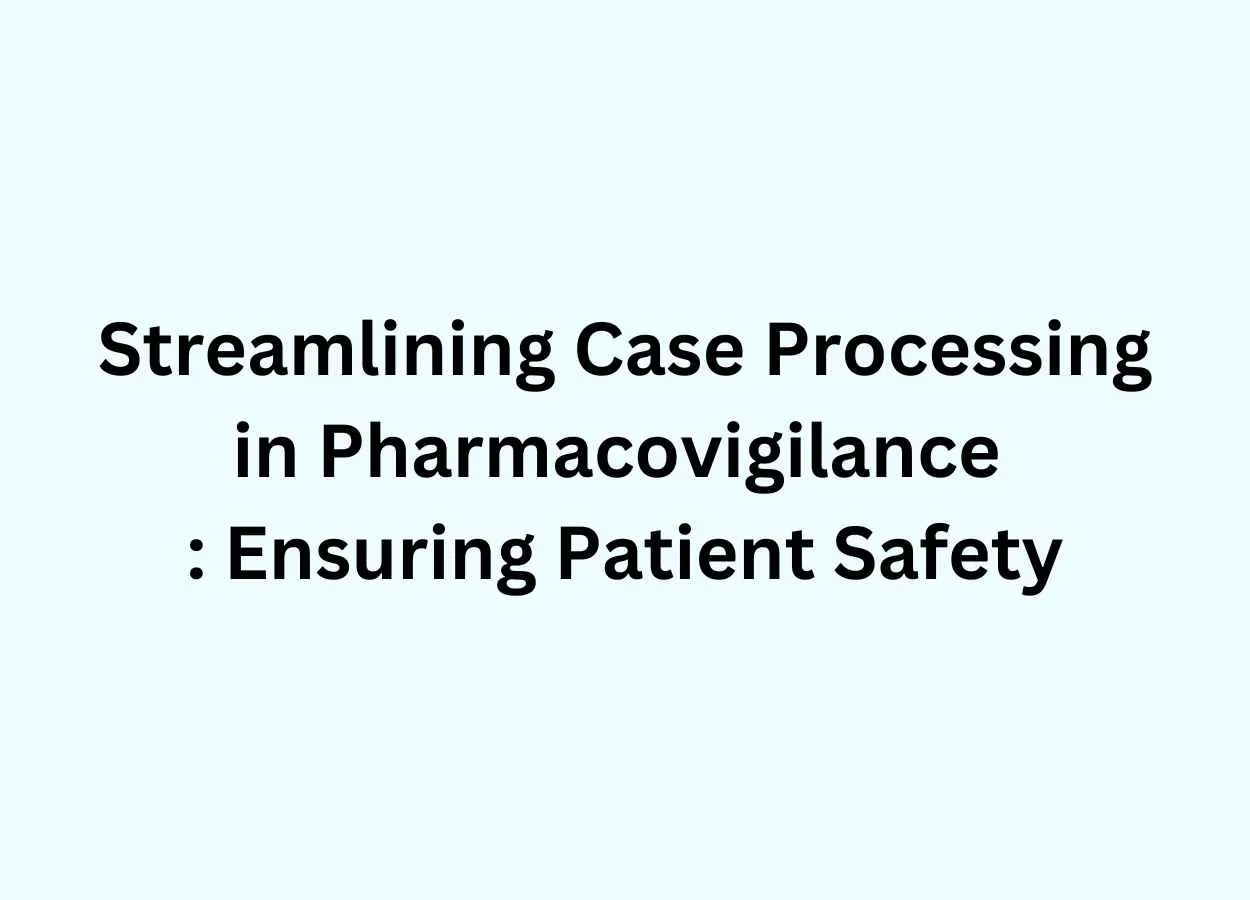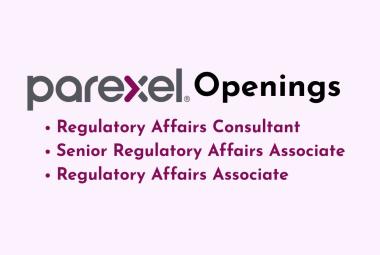Pharmacovigilance plays a crucial role in ensuring patient safety by monitoring, assessing, and preventing adverse drug reactions. Effective case processing within pharmacovigilance is essential for collecting, evaluating, and reporting adverse events associated with pharmaceutical products.
This article aims to explore the significance of efficient case processing in pharmacovigilance, highlighting key steps and challenges involved in the process.
1. Case Intake : The first step in case processing is the receipt of adverse event reports. These reports can originate from healthcare professionals, patients, or regulatory authorities. Proper case intake involves efficient data capture, ensuring essential information such as patient demographics, the suspected drug, and the adverse event description is recorded accurately.
2. Case Triage and Assessment: Once adverse event reports are received, pharmacovigilance experts perform case triage and assessment. Triage involves prioritizing cases based on severity and potential impact. Experts evaluate the information provided, including medical history, concomitant medications, and the temporal relationship between drug administration and the adverse event. This step helps determine whether the reported event is a genuine adverse reaction and warrants further investigation.
3. Case Narrative Development: Case narratives provide a comprehensive description of the adverse event, including relevant medical history, concurrent medications, and clinical course. Clear and concise narratives facilitate accurate evaluation and analysis of the reported adverse event, enabling Pharmacovigilance experts to assess causality and identify potential risk factors.
4. Coding and Data Entry: Coding adverse events using standardized terminologies (e.g., Medical Dictionary for Regulatory Activities - MedDRA) allows for consistent classification and comparison of data. Pharmacovigilance professionals assign appropriate codes to adverse events, drug names, and relevant medical conditions. Accurate and consistent coding ensures reliable analysis and enables effective signal detection.
5. Case Quality Check: Thorough quality checks are essential to ensure the accuracy and completeness of the processed cases. Data inconsistencies, missing information, or coding errors can compromise the reliability of Pharmacovigilance data. Quality assurance procedures, including double data entry, query resolution, and reconciliation, help identify and rectify any discrepancies before further analysis.
6. Database Entry and Management: Processed cases are entered into Pharmacovigilance databases, such as the Eudra Vigilance database in the European Union or the FDA Adverse Event Reporting System (FAERS) in the United States. These databases serve as repositories of adverse event reports and facilitate ongoing safety monitoring, signal detection, and aggregate reporting.
Types of cases processed in Pharmacovigilance
In Pharmacovigilance, various types of cases are processed to monitor and assess the safety of pharmaceutical products. These cases involve the collection, evaluation, and reporting of adverse events and other drug-related incidents. Here are some common types of cases processed in Pharmacovigilance:
1. Adverse Drug Reactions (ADRs): ADRs refer to any harmful or unintended response to a medication. Pharmacovigilance teams process cases related to ADRs reported by healthcare professionals, patients, or regulatory authorities. These cases include information on the drug involved, the nature of the adverse event, patient demographics, and other relevant medical details.
2. Medication Errors: Cases involving medication errors are also processed in Pharmacovigilance. These errors can occur at any stage of medication use, such as prescribing, dispensing, or administration. Pharmacovigilance teams investigate medication errors to identify potential risks and develop preventive measures.
3. Product Quality Issues: Cases related to product quality issues, such as manufacturing defects, contamination, or labeling errors, are processed in Pharmacovigilance. These cases involve assessing the impact of product quality issues on patient safety and determining appropriate regulatory actions.
4. Drug Interactions: Cases involving drug interactions are processed to evaluate the potential risks associated with concurrent use of multiple medications. Pharmacovigilance teams analyze these cases to understand the interactions, their clinical consequences, and potential mitigation strategies.
5. Medication Use in Special Populations: Cases related to medication use in special populations, such as children, pregnant women, and elderly patients, are processed in Pharmacovigilance. These cases focus on monitoring and assessing the safety and efficacy of medications in specific patient groups.
6. Off-Label Use: Cases involving off-label use of medications, where a drug is used for an indication not approved by regulatory authorities, are processed in Pharmacovigilance. Monitoring and evaluating these cases help identify potential risks and evaluate the need for regulatory action or changes in drug labeling.
7. Suspected Therapeutic Failures: Cases reporting suspected therapeutic failures, where a medication does not produce the desired clinical effect, are processed in Pharmacovigilance. These cases involve investigating potential reasons for treatment failures, including factors related to patient characteristics, medication quality, or dosing regimens.
8. Overdose and Intentional Misuse: Cases related to intentional or unintentional overdose or misuse of medications are processed in Pharmacovigilance. These cases help evaluate the safety of medications in different dosage ranges and identify potential risks associated with misuse.
Challenges in Case Processing :
Several challenges can impact efficient case processing in pharmacovigilance. These include a high volume of incoming reports, varying data quality, language barriers, incomplete or inconsistent information, and limited resources.
1. High Volume of Incoming Reports: One of the primary challenges in case processing is managing the high volume of incoming reports. As the number of adverse event reports increases, pharmacovigilance teams face resource constraints and time limitations. This can result in delays in case processing, potentially affecting patient safety. Implementing automated systems for efficient data capture, utilizing artificial intelligence for triage, and employing trained personnel can help streamline the processing of a large number of cases.
2. Varying Data Quality: Data quality can significantly impact the reliability and validity of case processing. Reports received from different sources may vary in terms of completeness, accuracy, and consistency. Missing or incomplete information, inadequate medical history, and ambiguous descriptions of adverse events pose challenges in proper case assessment. To address this, pharmacovigilance teams must establish clear guidelines for data collection, implement standardized reporting formats, and provide comprehensive training to reporters.
3. Language Barriers: Pharmacovigilance operates on a global scale, with reports originating from diverse regions and populations. Language barriers pose a significant challenge in case processing, as reports may be submitted in different languages. Translation and interpretation services, as well as employing multilingual staff or leveraging technology for language support, can help overcome this challenge. Ensuring accurate translation of case details is crucial to maintain data integrity and enable effective analysis.
4. Incomplete or Inconsistent Information: Incomplete or inconsistent information within adverse event reports can impede case processing. Lack of details regarding concomitant medications, medical history, or treatment outcomes hinders the assessment of causality and the identification of potential risk factors. Robust communication channels with reporters, such as query resolution systems or clarification processes, can help address incomplete or inconsistent information, ensuring accurate and comprehensive case processing.
5. Regulatory and Compliance Requirements: Pharmacovigilance operates within a complex regulatory landscape, with specific requirements for case processing and reporting. Compliance with these regulations, such as timely submission of reports and adherence to coding and data entry standards, presents challenges for pharmacovigilance teams. Dedicated training programs, continuous monitoring of regulatory updates, and the use of validated software systems can assist in meeting regulatory requirements and ensuring adherence to best practices.
6. Limited Resources: Limited resources, including personnel, infrastructure, and technology, pose challenges in case processing. Insufficient staffing levels, outdated data management systems, and inadequate access to relevant databases can hinder the efficiency of pharmacovigilance operations. Adequate allocation of resources, investment in advanced data management tools, and collaboration with external partners or vendors can help overcome resource limitations and enhance case processing capabilities.
How to overcome challenges
Pharmacovigilance teams must implement robust systems, advanced data management tools, and clear communication channels to address these challenges effectively.
Overcoming challenges in case processing within Pharmacovigilance requires a proactive approach and the implementation of effective strategies. Here are some key measures to address the challenges and enhance case processing:
1. Automation and Technology: Utilize automation and advanced technology solutions to streamline case processing. Implement electronic data capture systems, automated triage algorithms, and natural language processing tools to enhance efficiency and accuracy. Automation can help manage high volumes of incoming reports, improve data quality, and expedite case processing.
2. Standardization and Training: Establish clear guidelines and standard operating procedures (SOPs) for data collection, case assessment, coding, and reporting. Standardization ensures consistency and facilitates efficient case processing. Conduct regular training sessions for Pharmacovigilance personnel and reporters to ensure adherence to guidelines and improve data quality.
3. Collaborations and Partnerships: Collaborate with external stakeholders, including healthcare professionals, regulatory authorities, and industry partners, to address challenges in case processing. Establish effective communication channels to clarify incomplete or inconsistent information and resolve queries promptly. Foster partnerships to share resources, expertise, and best practices, which can help overcome resource limitations.
4. Enhance Data Quality: Implement robust data quality assurance processes. Conduct thorough quality checks and validations to identify and rectify data inconsistencies, missing information, and coding errors. Foster a culture of data quality through regular audits, feedback mechanisms, and continuous training.
5. Multilingual Support: Address language barriers by employing multilingual staff or utilizing translation and interpretation services. Develop multilingual reporting forms and provide clear instructions to reporters to ensure accurate and comprehensive data collection. Leverage technology solutions, such as machine translation, for efficient language support.
6. Regulatory Compliance: Stay updated with regulatory requirements and guidelines pertaining to case processing and reporting. Establish a regulatory intelligence system to monitor changes in regulations and promptly adapt processes accordingly. Maintain a robust compliance framework to ensure timely submission of reports and adherence to coding and data entry standards.
7. Resource Allocation: Allocate resources effectively to support case processing operations. Assess staffing needs and invest in adequate personnel to handle case volumes. Evaluate and upgrade data management systems, infrastructure, and technology tools to optimize efficiency. Consider outsourcing certain functions or partnering with specialized service providers to augment resources.
8. Continuous Improvement: Promote a culture of continuous improvement within the pharmacovigilance team. Encourage feedback, monitor key performance indicators, and conduct regular process evaluations. Implement corrective and preventive actions to address identified issues and enhance case processing effectiveness.
Conclusion : Effective case processing is vital for pharmacovigilance to identify and mitigate potential risks associated with pharmaceutical products. By streamlining the case processing workflow, improving data quality, and utilizing advanced tools and technologies, Pharmacovigilance teams can enhance patient safety and contribute to a better understanding of drug safety profiles. A comprehensive and efficient case processing system serves as the backbone of pharmacovigilance, ensuring prompt identification and evaluation of adverse drug reactions, ultimately protecting public health.









